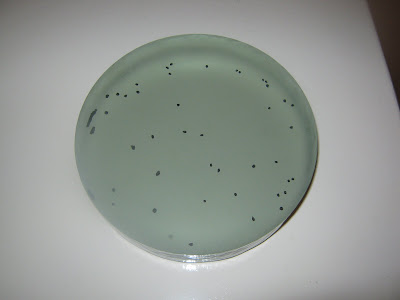16 April: 320

I recently unpacked my mirror for the first time since moving house. I had been working it with #220 grit for what felt like an extremely long time, and was impatient to finish the stage. I ground a few wets, dried the mirror and inspected the surface with bright light and a magnifying glass. Result: Lots of pits, and no way to remember what had been there before. The time had come to try out a trick I recently read about in the ATM mailing list: draw over each pit with a permanent marker, being sure to really lay the ink on thick. The results of this operation can be seen in the image to the left. Now the moment I begin grinding again, that ink will rapidly get scrubbed off, leaving only the ink inside the pit. Further inspections will reveal each pit as a tiny (but very obvious) black dot.
By the time I packed up my mirror that night, I was very excited – only about 6 dots remained. So you can imagine my dismay when I first inspected the glass at the ATM class on Saturday after grinding a few wets and found not one single black dot but plenty brand new pits. And a tiny (maybe a fifth of a millimeter) bubble which had broken through to the surface. At first I assumed that the ink trick simply wasn’t as effective as I’d thought, and kept on grinding. Eventually, starting to doubt my own judgement, I asked a more experienced member to check out my mirror. After several minutes, he proclaimed that the surface was beautifully smooth, and suggested that I progress to the next stage. So I fetched a supply of #320 grit from the stock cupboard, cleaned up with appropriate thoroughness, and started grinding.
Every single time I change abrasives, I’m astonished by how dramatic the change is. #320 grit is only about a third smaller than #220, yet it behaves very differently. It sprinkles out like fine flour, and turns into a fine, light-grey sludge the moment I spray it with soapy water. When I spread it around the glass with my fingertips, it feels more like a lubricant than an abrasive, yet it works very fast. After only three wets (each lasting about two or three minutes), I dried the glass and inspected the surface. I was intending to get a feel for #220 pits, but was astonished to find that I could hardly find any. I was also dismayed to see that there will still plenty #120 pits.
I took it to the quartermaster, and asked his opinion. He then spoke to me of the phenomenon known as Subsurface Fracturing. It turns out that the grinding process is far more destructive than I had realised. I learned that as each individual piece of grit is scraped between the two glass surfaces, it scratches a rough groove along the surface. With thousands upon thousands of these scratches being dug on each stroke, they rapidly add up to an overall erosion of the glass surface. But the scratch is not cut into the glass — it is crushed in. Each tiny piece of grit mashes through the glass, smashing and splintering its way across the surface, albeit on a very tiny scale. And as you’d expect with glass, this causes cracks to spread out from each tiny impact, down into the glass. Then, once you’ve moved to the next finer grit and abrade at an even smaller scale, these cracks come into play so that little chunks of glass pop out creating a brand new pit on the same scale as the previous level of grit (or sometimes even larger). All of which we see as new pits spontaneously appearing out of nowhere.
So how am I supposed to deal with this? Simple. Keep grinding! Grind and grind away until I’ve gotten past the deepest cracks (not very deep at all, actually, but with such fine grits it still means many more hours of work). So here I sit, with my powdery #320 grit, and brand new enormous pits opening up. I’ve got a lot of work to do at this level. Still, by responding properly to this situation, I’ll end up with a much smoother and cleaner surface. It’s worth the effort.
